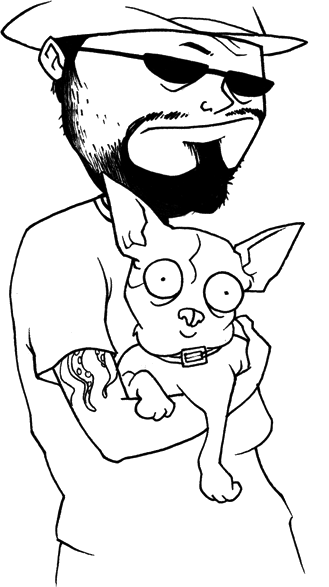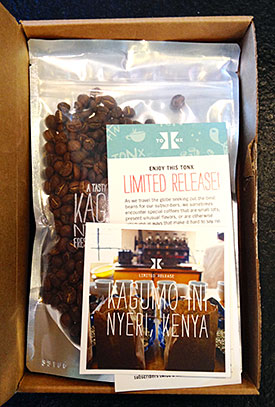Current Status
I am currently Somewhere In Between.

I am currently Somewhere In Between.
It was a great pleasure to have this conversation with my longtime garden hero, Gayla Trail. We talk desert plants, my San Francisco cloud forest, and botanical tattoos. If that sound like fun, you’re my kinda plant nerd. Go give it a listen.
An edited version of this article first appeared in Wired.
Here’s what happened in plain English. Twitter has a feature called “Block.” If I block you on Twitter, you can no longer interact with me (follow, retweet, favorite, etc). Last week, Twitter changed block so that previously blocked people could once again interact with the people who had blocked them. And those people were pissed.
After an intense night of thrash, including a lively #RestoreTheBlock hashtag, Twitter reverted the change. Now, then. What have we learned? And what can other companies with large communities take away from this teachable moment?
1. You can’t change the rules in the middle of the game.
People were upset for good reason. They’d spent years adding jerks, haters, and abusers to a carefully crafted block list. The agreement these people had with Twitter was simple: “I don’t want these people to interact with me again.”
Twitter changed that without warning. Suddenly everyone in that blocked group could interact with you again – follow you, retweet your tweets, etc. This broke Twitter’s agreement with its users.
Worse, when those blocked people now interacted with you, Twitter would hide it from you. So if someone was harassing you, all your friends could see it, but you could not. They changed block from something you did to others, to something you did to yourself.
Had they added a new feature called “Mute” that operated the same way the new block did, alongside the current block, no one would have complained. But to change the way an existing community tool worked, especially one so central to the safety and sanity of users, is to court disaster.
2. You can’t make changes in secret.
The change itself was a bad idea. Compounding the badness was how the change was communicated to users: it wasn’t.
Implementing the change with no word or warning created the appearance of Twitter trying to sneak something past its users. I’m not saying that was their intent, but the way it rolled out was guaranteed to make it look sneaky.
Talking to TechCrunch and updating a FAQ is not communicating with your users. Twitter is a communication platform. They have absolutely no excuse for a lack of communication.
When you make a change to a core piece of community functionality, you have to tell your users about it directly, in advance, solicit their feedback, and then listen. You can’t make a change and hope nobody notices. They always notice.
3. Never punish the victims.
The most outrageous part of this whole story is that, despite Twitter’s claims to the contrary, they were fixing the problems of the harassers who got blocked, not the people who were doing the blocking.
I’ve managed many communities with tools like this, and worked with many more, and you’d be amazed how common it is for people who misbehave and get punished to come crying to the admins. But scratch the surface of their complaints and, nine times out of ten, they were the ones in the wrong. “Well, yeah, I did break the rules, but I still shouldn’t be punished!”
Twitter, when faced with years of complaints from the blocked, capitulated to them by restoring access to the users who had blocked them. Then they had the gall to claim that this change would be good for the people who did the blocking.
When making a core policy change like this, always ask yourself, who’s problems are we solving? And what additional problems might we create? Had Twitter spoken to any real users about this change, they would have heard loud and clear what a bad idea it was.
4. Large communities need more than one management tool.
Block is a necessary tool for communities to manage themselves, but it’s not the only tool you need in a community of millions. In the past I’ve likened it to “setting the dinner table with only chainsaws.” We need more humane, nuanced tools for people to manage their networks, and their attention.
What Twitter tried to do is change Block to Mute. A block tool severs the ties between two users. But a mute tool is a simple filter: “Don’t show me stuff from that guy, or stuff that contains these words.” The fact that many third-party Twitter clients have built their own mute tools is proof that it’s needed. Twitter should add it natively without taking away the existing block tool.
There are many more tools that could and should be added. Humans are weird and messy and we require weird and messy tools. Here are a few top-of-my-head examples.
I acknowledge that none of this is easy. But neither is creating a realtime multi-platform messaging platform that is used by millions, and Twitter has accomplished that. I know they could do better if they wanted to, and I know that if they don’t, their users will let them know about it. In the meantime, it’s a teachable moment for the rest of us building community online today. One that I hope the rest of the industry is paying attention to.
Say you’re a supervillian. Your goal is not to take over the world, but to create more unpleasantness. So you set out to create a device that would ensnare normal, rational people and turn them into ranting lunatics. What would your Argument Machine look like? How would it work?
(Note that I mean “argument” not in terms of academic debate, which is healthy, but in the everyday “unproductive, unpleasant, angry fight” sense of the word.)
First, the machine would have to be online, so it could reach the maximum amount of people with the least amount of construction. People feel protected online, like they do in cars, so they’re more willing to fight. But it shouldn’t be just a website. It would also have to be an app on all the major platforms for maximum reach.
All arguments have a beginning, so we’ll create a tool for people to post their thoughts. This should be as easy as possible, so people do it without thinking too deeply. Forethought is the enemy of a nasty argument.
Arguments tend to fizzle out quickly if the participants are able to make a fully fleshed-out thought, so we’ll limit every thought to a ridiculously small size, say 140 characters. Brevity may be the soul of wit, but it’s also the root of misunderstandings.
We’ll then take those short thoughts and present them immediately to the audience, without any ability to edit them after the fact. We’ll even create a “reply” affordance that seems like it’s private, but we’ll actually show the reply publicly. Nothing creates a fight faster than in-group language overheard by the out-group.
To maximize negative reactions, we’ll design the presentation of these short thoughts to create annoyance. Tests have shown that information coming in too fast can create anger and defensiveness, just like someone interrupting you in real life, so we’ll make everything as fast and interruptive as possible. We’ll also pack the app with lots of notifications, so we can make people’s pockets buzz every time someone mentions them. Just like the electric shocks we used on those lab rats.
If someone isn’t receiving enough of these short thoughts to overwhelm them, then we’ll blanket them with suggestions of other people they should be hearing from, to encourage all new members to quickly reach an overwhelmed state.
With enough people, and enough short thoughts, arguments are sure to occur. When they do, we’ll add heat to them by making sure everyone can see the individual thoughts outside of the argument’s participants. Nothing like a hooting crowd to make a bad situation worse. We’ll even add a tool to allow others to repeat the thoughts to a wider network (out of context, of course). The more people who pile in, the longer the argument will last, the more people will participate.
If everything goes well, the mainstream media will start monitoring these thoughts, so that they can embarrass famous people when they speak out of turn. We’ll even create an way for people to embed these thoughts on other sites so that they remain even after the original poster deletes them. Gotcha!
Nothing is better at creating new arguments than other arguments, so once we reach a critical mass, avoiding arguments will be impossible. Now all we have to do is sit back and practice our supervillian laugh. And maybe go public.
+
I think you get my point by now. Yes, I’m talking about Twitter.
I’m not saying that Twitter was designed to create arguments. I’m just saying that, if you set out to create an Argument Machine, it’d come out looking a lot like Twitter.
I think Twitter is awesome. As of today, I’ve tweeted more than 16,000 times. It’s the community tool I use more than any other. But with Twitter preparing to IPO and monetize all of us, I worry about the health of the community the tool produces.
If Twitter cared about avoiding arguments, there are so many things they could do: remove the outdated character limit, let us edit tweets, create progressive circles of privacy, don’t let retweets out of our networks, slow the whole thing down, and encourage smaller communities. But they’re not going to do any of those things because the financial pressure points in exactly the opposite direction: more users, more tweets, faster and faster. Who cares if they’re fighting?
Well, I do. I want Twitter to succeed. But every time I see some innocuous tweet spawn another long, bile-filled thread of awfulness, I become less interested in tweeting. I know, arguments will always happen, online and off. But the design of the tools we use can encourage or inhibit this human tendency, and I’m afraid Twitter is falling very far into the “encourage argument” side of things. And I’m not alone.
Where will we go when we all tire of getting yelled at on Twitter? What would a tool designed to create a harmonious exchange of interests and ideas even look like? I’m confident we’ll find out eventually, but I seriously doubt its logo will be a little blue bird.
+
Or: I have some awesome job news.
You learn things when you start a company. When I cofounded 8020, I learned to ask the difficult questions. When I cofounded JPG Magazine with my wife, I learned how important it was for everyone to be in charge of something. And when I founded Cute-Fight, I learned … a lot.
Cute-Fight taught me that there’s a certain skill set required to raise venture capital, and it’s not one I really want. It taught me that I really do like managing people, especially when they’re as talented as that team. It taught me that running a startup is mostly about setting priorities and convincing people that they’re the right ones.
But most of all, running Cute-Fight reminded me of some things I already knew but had gotten lost somewhere along the way. It reminded me that I really love making products for specific communities, nurturing the garden, and seeing what blooms. And it reminded me that I really like writing.
At Cute-Fight, with the design, illustration, and engineering all in excellent hands, I did whatever was left over. And most of what was left over was writing. Writing the newsletter, responding to member emails, crafting every word that appeared on the website.
It’s funny that a guy with a journalism degree and 20 years of work in and around the publishing industry should have to rediscover his love of writing, but there you go. I think it just got buried under lofty terms like “experience design” and “content strategy” and “community management.” All those things, at their core, are about putting the right words in the right order.
So when it became clear that Cute-Fight was not going to pay my bills, and, worse, that I had gone into debt chasing the startup dream, I started looking for work with increasing desperation. I made some mistakes in this process. Mistakes I feel bad about now. Suffice to say, it was a rough time. But this is a story with a happy ending.

A couple years ago, Nik and Tony started a company called Tonx. The idea was simple: get the best coffee beans from all over the world, expertly roast them, and mail them to subscribers every two weeks.
I’d been a Tonx subscriber since the start, and Nik and Tony had become internet friends. Tonx was the first company to sponsor a Cute-Fight venue, and while we were working that out, I was impressed with how smart, generous, and passionate they were.
In a couple visits to San Francisco, Nik and Tony told me about their plans for the future of the company. It hit me in a flash: Tonx is a biweekly magazine published in bean form. What JPG Magazine was to photography, Tonx is to coffee.
“What you need,” I said excitedly, “is someone who can write and edit, with experience in publishing and community building.” They both smiled and asked me if I knew anyone like that. Only then did it sink in that they were offering me a job.

I’ve been working as Tonx’s Editor in Chief for a couple months now, and it’s been a joy. It’s all the parts of what I loved about doing Cute-Fight – writing, community, product – with an amazing team of engineers, coffee pros, and a rapidly growing member base of devoted (and caffeinated) customers.
Coffee maintains a special place in creative culture. When I think back to my happiest moments, coffee was always nearby. It’s a daily morning ritual that I share with millions of other people. It’s a connective thread that ties our lives together. With such a hot, emotional product, there’s no end to the collaborative projects we could do.
 So we’ve got plans. Big plans. I can’t go into detail yet, but if you know me and my work, you may have a general idea. You can see the humble beginnings in The Frequency, where we’re adding weekly travelogues, reviews, and photo essays – not just about coffee but coffee culture at large. They’re the right words, in the right order, as much as we can.
So we’ve got plans. Big plans. I can’t go into detail yet, but if you know me and my work, you may have a general idea. You can see the humble beginnings in The Frequency, where we’re adding weekly travelogues, reviews, and photo essays – not just about coffee but coffee culture at large. They’re the right words, in the right order, as much as we can.
One of the most challenging things about being a startup CEO that nobody tells you is that, when it’s over, it’s terrifying to go back to being someone else’s employee, working on someone else’s vision. Once you sit in the big chair, every other chair feels too small.
My only advice for someone in that situation is this: use the experience to figure out which parts are required for your happiness and try to find that somewhere else. If you’re extremely lucky, you’ll find a team of talented people working on something awesome who need someone in exactly that role. I was that kind of lucky and I’m so incredibly grateful I can’t even describe it.
If you love coffee, sign up for Tonx. You won’t regret it. And I’ll be on the other end of that line with the rest of the team, working on some exciting stuff for you.
Ever forward!
You made it to the bottom! You must be very good looking. Wanna go back to the top now?
Hi, I’m Derek. I make awesome community-centric web stuff. I sometimes post things to Flickr and Twitter. I’m mostly harmless. More.
© Copyright Derek Powazek, all rights reserved. If you like something here, link to it, don’t copy it.
This site is powered by WordPress and expertly hosted by Media Temple.